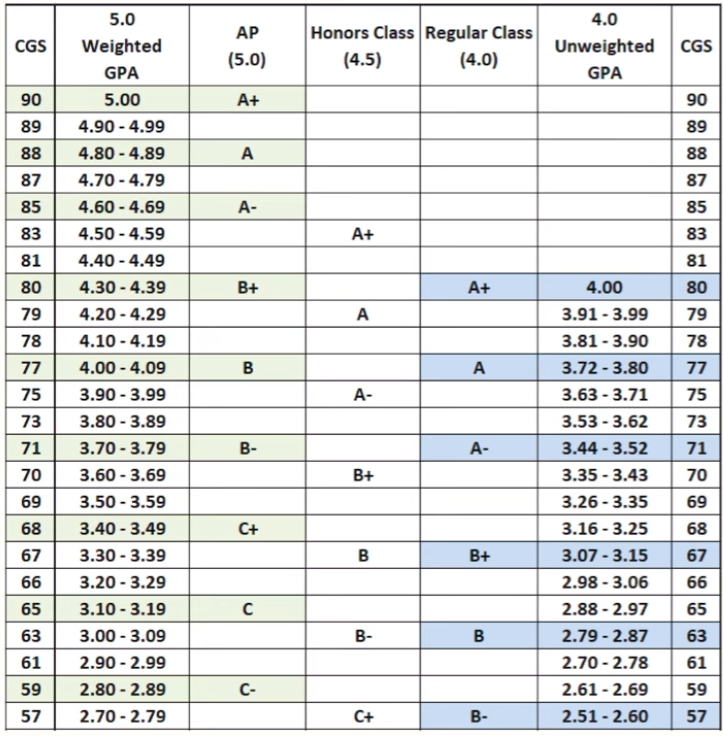When choosing high-level courses, students often ask:
Should I take AP classes?
Should I take Honors classes?
Should I stick with Regular classes?
It can be hard to decide, especially when you’re unsure how each choice might affect your GPA. My goal is to clarify that today so you can stop second-guessing your decisions.
Many of you might ask:
"If I take AP or HL classes and my grades drop a little, will that still look better than getting perfect grades in easier courses?"
To answer this, I’ll explain how U.S. colleges evaluate GPA.

The chart referenced above is the same one introduced in Part 1. It’s the system many U.S. colleges use to calculate GPA.
To summarize from Part 1:
-
Colleges begin with the transcript provided by your high school.
-
If both weighted and unweighted GPAs are shown, they use the unweighted GPA first.
-
Each grade level is weighted equally. Senior-year grades may be slightly discounted depending on the school’s term system.
-
Because grading scales differ by school, colleges convert everything to a 4.0 scale, eventually producing a CGS (Converted Grade Score). A high CGS gives you a clear advantage.
For IB schools:
-
Early applicants are evaluated based on one year of grades.
-
Regular applicants are evaluated using one full year plus one semester (or one trimester).
-
If available, predicted grades are used.
-
For IB schools outside the U.S., HL subjects receive double weight.
This process—converting to CGS based purely on numbers—is what colleges call the Quantitative Score. Since this part is calculated without regard for course difficulty, it might seem like there’s no real benefit to taking harder classes.
But after this first step, colleges add a Qualitative Score, which accounts for rigor and other contextual factors. Today, we’ll explore two main methods colleges use for calculating this second layer.
The two most common methods are:
-
Utilizing a Converted Table
-
Applying Additional Weighting
Surprisingly, both methods often produce very similar results.
Utilizing a Converted Table

In this method, colleges apply a standardized table to assign points:
-
Regular A+ = 4.0
-
Honors A+ = 4.5
-
AP A+ = 5.0
Using this system, getting an A+ in an AP course earns the highest possible CGS score. However, getting a B+ in AP might only be equivalent to an A+ in a Regular class. Here's how the comparisons look:
-
Honors A+ ≈ AP A ~ AP B+
-
AP B = Regular A
-
Honors A+ ≈ A–
Let’s take an example:
Assume a student takes four classes—one each in Regular, Honors, and AP—and receives the same grades.

Under the Quantitative Score system (based on unweighted grades), all categories end up with the same average: 71.75.
Now, let’s apply the Converted Table:
-
Regular total: 71.75
-
Honors total: 74.75
-
AP total: 83.75
The jump from Regular to AP yields a much larger gain than from Regular to Honors.
But what if the student receives lower grades due to course difficulty?

Regular: All A+
Honors: All A
AP: All B+
Quantitative Score (no extra weighting):
-
Regular = 80
-
Honors = 77
-
AP = 67
Now apply the Converted Table:
-
Honors adds some value, but AP B+ receives a 12-point boost, lifting it to a total average of 80—the same as Regular all A+.
So, even with a B+ in AP, you can match the CGS of a student with straight A+ in Regular classes. However, if your grade drops below B+, the benefit starts to fade.
Applying Additional Weighting

Now let’s consider another method: directly adding extra points for course difficulty. This method varies by school, but here’s a general example:
-
Honors: +3 points per class
-
AP Core: +13 points per class
-
AP Elective: +9 points
-
IB SL: +6–7 points
-
IB HL: +12–14 points
If a student receives the same GPA in all courses:
-
Regular (no bonus): 71.75
-
Honors (+3 per class): 74.75
-
AP Core (+13 × 4): 84.75
-
AP Elective (+9 × 4): 84.75
Now assume the student does not get identical grades:
-
Regular: All A+
-
Honors: All A
-
AP: All B+
Apply the bonus points:
-
Honors: Add 12 total
-
AP Core: Add 13 per class
-
AP Elective: Add 9 per class

Total average again reaches 80—the same as Regular all A+.
The key takeaway is this: one A or A+ in an AP class can tip your combined Quantitative + Qualitative Score above someone who earned straight A+ in easier classes.
So regardless of which method is used—Converted Table or Added Weighting—the final outcome is similar: a B+ in AP is still a solid result. But anything below that may not justify the course difficulty from an admissions standpoint.
Still, rather than avoiding the challenge, I encourage students to try higher-level courses each year and build academic resilience.
What’s most surprising is that these two models are only a fraction of the broader system. In reality, colleges use dozens of GPA evaluation methods—around 50 are known—but their patterns tend to follow similar logic.
That’s why my final recommendation is this:
Take the AP or HL classes, and aim for at least a B+.
Even if it’s tough, the long-term benefit is clear.
Today’s post explained how GPA is calculated in U.S. college admissions. If you have further questions, feel free to contact A-One Institute.
Thank you!
AP
Honors
GPA
